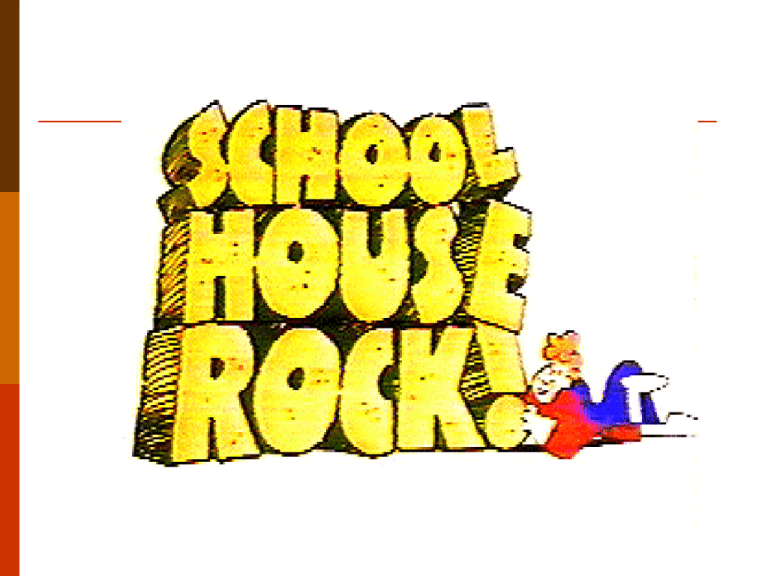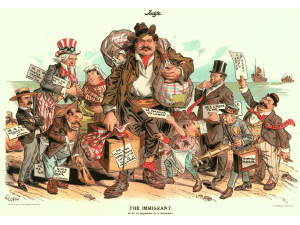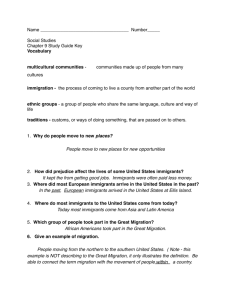With white background for printing
advertisement

The Great American Meltin' Pot Schoolhouse Rock -- Clip.url America was founded by the English But also by the Germans, Duch, and French, The principal still sticks Our heritage is mixed So any kid could be the president You simply melt right in, It doesn't matter what your skin. It doesn't matter where you're from, Or your religion, You jump right in To the great American meltin' pot. Great American meltin' pot Provenzo Chapter 8 Immigration, Education, and Multiculturalism E Pluribus Unum (one from many) European traditions and beliefs Most immigrants before 1890: Protestants from Northern Europe U.S. culture at that time reflected the traditions and beliefs of northern Europe. Legitimate versus imposters Conflicts between old and new immigrant groups common. Earlier groups considered themselves to be legitimate U.S. citizens. Established groups viewed new immigrants imposters or trespassers. Nativist Movement: 1830 – 1840’s Antiforeign groups Believed new immigrants subvert democratic values. Catholics feared to owe allegiance to the Pope Legislation restricting immigration 1860 and 1890 population doubled (30 million to 60) million. 1880s immigrants from southern and eastern European countries. Legislation restricting immigration: first time in 1882. The Americanization of Immigrants Education primary means to Americanize and assimilate new immigrants. Excluded from the melting pot “Melting Pot”: immigrants assimilated into culture through education and acculturation. Does not correspond with reality of U.S. experience. Many immigrant groups maintained their ethnic identity. Melting pot did not take into account immigrants and ethnic groups who did not easily blend into the culture. Asians, African Americans, Native Americans, and others were excluded from this process of fusion and amalgamation. E Pluribus Unum: One from many Many cultures coming together to create single culture Cultural Pluralism Immigrants preserve best of old-world cultures Gradually assuming U.S. customs, beliefs. Ethnic minorities encouraged to preserve own traditions While taking active part in economic and social life of the United States. Strength as a nation derives in large part from the diversity of its ethnic cultures. Pluralism embraces all people Regardless of backgrounds, beliefs. WASP remains only on of many groups within the culture. Traditional mainstream assumptions Monoculturalism Argues diverse ethnic, racial groups need become like traditional mainstream culture Liberal multiculturalism •Individuals from diverse groups share natural equality and common humanity •Toward a universal equality made up almost exclusively of Western and white middle-class assumptions Pluralist multiculturalism Most widely accepted model of multiculturalism. Emphasizes difference between various ethnic and cultural groups rather than focusing on sameness. Left-essentialist multiculturalism Essential, unchanging characteristics define culture. Exclusiveness and solidarity preclude outside understanding, involvement. FUBU, Radical feminism Critical multiculturalism Recognizes humans as social beings Shaped by range of economic, political, cultural forces. Understanding power and power relationships is essential in this model. Ethnicity Extraordinarily complex phenomena. Sense of peoplehood developed through language, traditions. Bilingualism and U.S. Education Most immigrants have learn a new language As a national language, English is a powerful force in their assimilation. Bilingualism: controversial, emotional issue. Federal support for bilingual education began in 1968 with Title VII, the Bilingual Education Act, amended the Elementary and Secondary Education Act (ESEA) of 1965. Reflection questions: 1. What are the advantages of the diversity (gender, age, ethnicity, sexual orientation, occupation, religion or denomination, political affiliation) in the United States? 2. What are some of the serious problems that arise from this country being a multicultural society? 3. How important is it for the schools to Americanize immigrant children? 4. What are some of the problems that can occur when the schools take on this task? 5. Should quotas be set on the number of people allowed to immigrate to the United States? 6. If yes, how should the quotas be determined? 7. Is bilingual education something that should be supported by the schools and the culture in general? CPS question: What do you think? Can schools and the educational system support immigrant traditions and U.S. values simultaneously? (Provenzo 170) Historical Events Clayton, Jackson, McGhie Hanging The lynching of nineteen-year-old Elias Clayton, nineteen-year-old Elmer Jackson, and twenty-yearold Isaac McGhie. June 15, 1920, Duluth, Minnesota. Cultural Event: GLBT pride festival 1. 2. 3. 4. Teams of three: sign bearer Create three or more signs with words, symbols, slogans found in parade, on sidewalk, in support, in protest of parade Identify the Provenzo cultural stance of sign bearer Offer individual’s argument for sign 1. Teams of three: journalists 2. Prepare two or more interview questions for sign bearers from each Provenzo cultural stance 3. Remember you’ll interview supportive folks and nonsupportive follks 4. Practice your questions on each other







